Noticing a sudden decline in your website’s organic traffic can be a nightmare for businesses and marketers alike. But it’s not an uncommon occurrence. Even successful sites aren’t immune to experiencing a slump in organic reach. If you’re currently witnessing reduced visits to your site without any apparent explanation, don’t fret! I’m here to show you proven ways to recover organic traffic using several trusted strategies developed based on years of experience in this field.
Let’s first examine the possible reasons behind this unexpected drop in rankings or visibility.
Understanding the reasons behind a decline in organic traffic
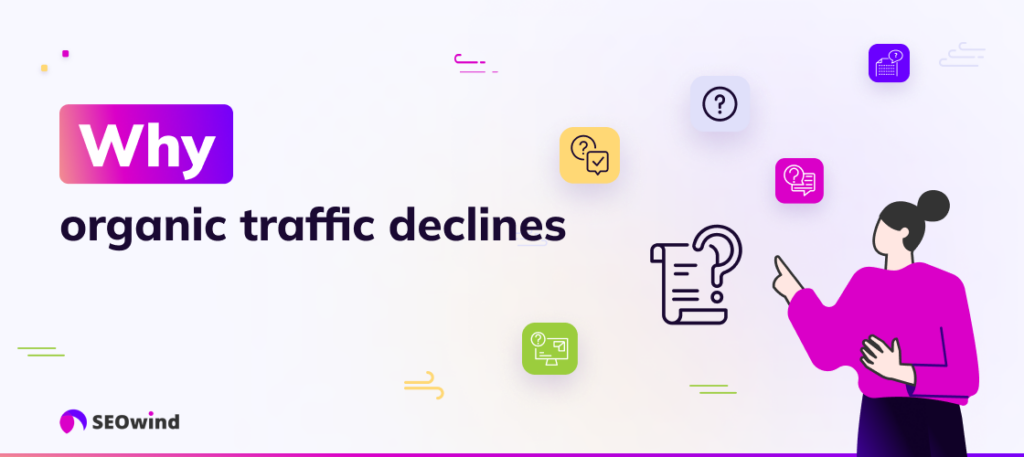
Google Penalties and Manual Actions (Helpful Content Update 2023 and March Core Update 2024)
Google routinely refreshes its algorithms to ensure top-quality content for its users. Take ‘Helpful Content updates 2023’ and ‘March Core update 2024’ as an example. However, these updates could impact your website traffic if the search engine flags any spammy tactics or violations of webmaster guidelines on your site. Remain vigilant about these manual penalties since they tend to cause significant drops in visibility.
Poor Quality Content Issues
As emphasized by seoworks.co.uk, “Google rewards pages that reflect current expert consensus.” This implies that producing up-to-date, relevant content isn’t optional; it’s essential! High-quality content is an investment well worth making, but abandoning it once posted can ironically turn it into a liability over time due to “content decay.” This happens when old content doesn’t receive fresh updates, allowing competitors to exploit this lapse with refined strategies.
Technical Problems and Slow Website Loading Speed
Technical issues such as URL changes, 404 errors, or sluggish page speed can devastate your organic traffic. Google favors websites that offer seamless user experiences, which require fast loading times. Since potential visitors generally don’t hang around for slow-loading sites, it goes without saying that ignoring tech issues is not an option.
Loss of Quality Backlinks and Negative SEO Attacks
Backlinks from reputable sources partly determine your website’s authority and relevance. Losing these valuable backlinks due to scrapped pages or changed URLs can considerably decrease organic traffic. Additionally, beware of unscrupulous competitors resorting to negative SEO attacks by intentionally duplicating your content or building harmful links to your site. Both inevitably harm your site’s reputation and visibility.
How to identify the causes of organic traffic drop
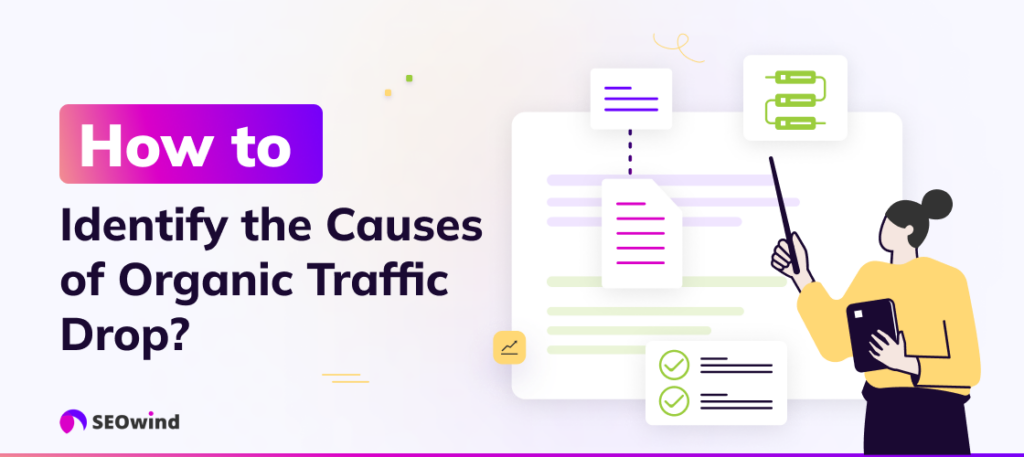
Before proceeding with recovery strategies, it’s crucial to diagnose the root causes of a drop in organic traffic. Understanding these factors will provide insights into how to navigate your efforts for maximum results strategically.
Use Google Analytics and Search Console for Data Analysis
Your first go-to sources should be Google Analytics and Google Search Console. These efficient tools can help identify errors or penalties affecting your site rankings and, ultimately, your website traffic!
Be patient as you dig deep into these data-rich platforms. In Google Analytics, check various reports concerning user behavior, bounce rate, demographic data, and more. Meanwhile, Google Search Console can highlight crawling issues or schema problems. Also, keep an eye on any significant ranking changes across your website’s primary keywords.
Keep in mind that tracking errors can lead to misleading reports of reduced traffic, but they are usually easier to fix than actual traffic loss.
Monitor Page Indexing Status and Content Quality Assessment
Conduct a thorough content quality assessment once any discrepancies have been identified through data analysis. Your goal here is twofold: first, ensure that search engines correctly index all necessary web pages, and second, align existing content with SEO best practices.
It involves checking your meta descriptions or page titles for missing gaps or performing audits on keyword density within high-traffic pages. It also means evaluating whether there has been an incidental trend towards thin or poorly researched content that may dissuade search engine bots and cause them to deprioritize indexing those pages.
Check For Lost Backlinks And Mobile Responsiveness
Lastly, conduct a backlink audit. Do you have any backlinks that were valuable at one point but seem lost now? Has there been a surge of low-quality links leading to your site? Your backlink profile directly affects your organic traffic, making it imperative to monitor regularly.
Also, assess your site’s mobile responsiveness. Given the increasing number of mobile users and Google’s mobile-first indexing, ensuring a seamless experience for mobile visitors is non-negotiable.
Diagnosing and identifying the causes requires systematic analysis and a comprehensive approach. It establishes a foundation for all subsequent steps related to recovering your website’s organic traffic.
The next phase focuses on strategically addressing these identified issues.
7 strategies to regain organic traffic and improve ranking positions
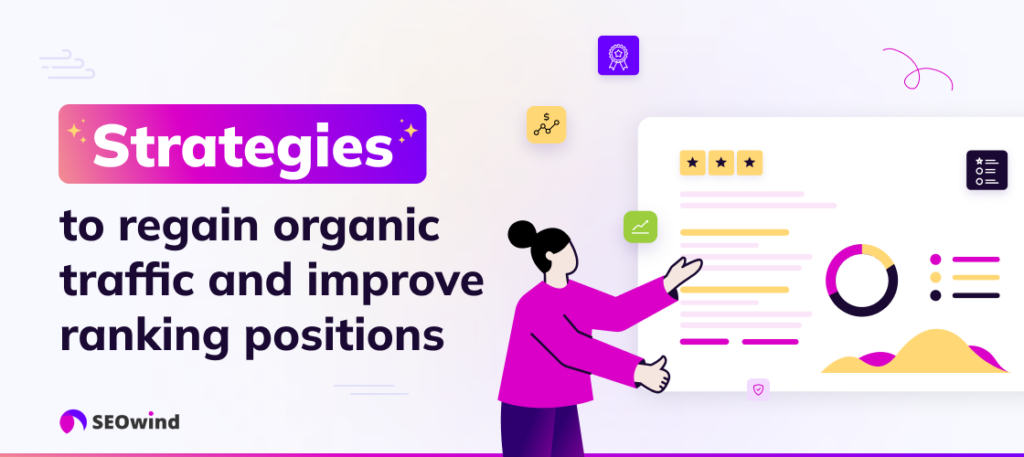
Navigating organic traffic recovery can seem daunting. Fortunately, the digital marketing landscape offers numerous effective strategies for reclaiming your website’s visibility in search engine results. These methods are designed to help you regain lost ground and establish a stronger position down the line.
1. Enhance Content Relevance and Quality
The first step in tackling traffic loss due to algorithm updates is boosting both the relevance and quality of the content featured on your site. Content is more than words and includes images, videos, and infographics that provide value for visitors.
Ideally, each piece of content should be unique and reflect expertise on the subject matter; a Google update from 2023 clearly signaled this intent. It’s also important to avoid overusing or underutilizing keywords, as such practices can tarnish content performance.
Instead, focus on creating high-quality content that answers readers’ queries directly while providing insightful information about the topic. Remember, every well-designed piece of content evokes interest from readers, who are likely to spend more time exploring your site, boosting visibility via increased dwell time.
2. Tailor Content for User Intent and Search Queries
Understanding user intent reveals users’ needs, sometimes even before they fully recognize them. By aligning your content strategy with user intent, you give people what they genuinely want or need.
- Identify popular queries: Use tools such as Google Keyword Planner, Semrush, or Moz Keyword Explorer to discover what exactly your intended audience is looking for.
- Analyze SERPs for query interpretation: Look at the search engine result pages (SERP) of those key queries to determine how search engines interpret them.
- Align your content accordingly: Based on this insight, realign your content strategy, including blog posts, product pages, and instructional material.
Above all else, always remember that more effective alignment between user intent and your website’s content enhances visitor satisfaction and loyalty, making them far likelier to become repeat customers!
3. Build High-Quality Backlinks and Social Media Promotion
Backlinks are significant because Google perceives them as votes of confidence, which boosts your visibility in the virtual realm. Losing quality backlinks can decrease organic traffic, requiring quick attention if you want to recover.
Simultaneously augment your site awareness by leveraging social media promotion strategies. Engage with followers via comments or queries and publish posts with visually appealing content and crisp copy. All of this material should attempt to serve users while attracting more eyeballs to your brand.
4. Leverage Paid Advertising Strategies for Recovery Efforts
While our primary focus is on recovering organic traffic, adopting paid advertising can prove beneficial during the transition phase. Start small with subtle advertisements targeting key demographics that align with your products or services.
Paid advertising offers an immediate opportunity to regain some lost traffic. However, this only works as a complementary solution to optimization that enhances SEO rankings.
These steps collectively enable you to act proactively to reduce the impact of algorithm updates, ensuring you can retain organic traffic while improving ranking positions.
5. Optimizing for Position Zero and Featured Snippets
If maximizing visibility amid search results is a game, scoring position zero – Google’s featured snippet box – amounts to gaining an extra bonus! This coveted spot boosts exposure by giving potential visitors instant access to some highlighted information from your page.
Here’s how you strive for it:
- Target question-based searches: Make sure that part of your content answers FAQs within your niche.
- Adopt a crisp format: clarity is essential. Concise paragraphs (40-60 words), bullet points, or tables are favored for these snippets.
- Leverage Schema Markup: Implement Structured Data to provide search engines with more explicit information about your content.
Remember, the path to position zero isn’t simply about traffic but also about building a reputation as a trusted thought leader within your field.
6. Resolve Technical Issues and Site Structure Problems
Technical glitches like slow loading speeds could severely hamper the user experience, leading to reduced rankings that affect organic traffic. Therefore, I highly recommend performing a tech audit to check how smoothly bots crawl through your website.
Issues such as broken links can hinder crawling, which may prevent some pages from being indexed by search engine bots. Also, pay attention to mobile optimization, which can significantly impact rankings if not addressed promptly.
Site structure problems arise when users find your website difficult to navigate because the blueprint lacks clarity, forcing them to visit competitor sites instead. Make sure to use an intuitive design that people can easily understand, helping them stay longer and increasing their chances of conversion.
7. Implement Accelerated Mobile Pages (AMP) for Mobile Visibility
Website loading speed is a silent killer. A lag in performance can dramatically harm user experiences and subsequently hamper organic traffic. According to research, coherent link-building strategies focusing on high-quality links rather than just quantity can help improve organic traffic and rankings while addressing load time problems via AMPs and accelerating content delivery on mobile devices without compromising functionality.
Consider these steps:
- Implement AMP plugin in CMS: Most popular content management systems (CMS), including WordPress, Joomla, and Drupal, offer this option.
- Properly set up AMP versions of pages: Ensure that you maintain the same structured data markup on your standard page and its corresponding AMP page.
- Test and validate: Google Search Console provides an enhancement report to identify any issues with your AMP setup.
Going forward, optimizing website speeds through AMP implementation won’t just replenish lost traffic. It’ll also boost overall site engagement levels and conversion rates among mobile users! After all, nothing beats getting lightning-fast answers!
How can SEOwind help you recover organic traffic?
Whether you’re overwhelmed by volatile rankings or grappling with a significant dip in your site’s organic traffic, SEOwind offers solutions tailored to restore and even enhance your website’s visibility. Using the power of AI, SEOwind combines content research, data analysis, individual understanding, and dynamic strategy formulation to devise potent practices for regaining lost organic traffic.
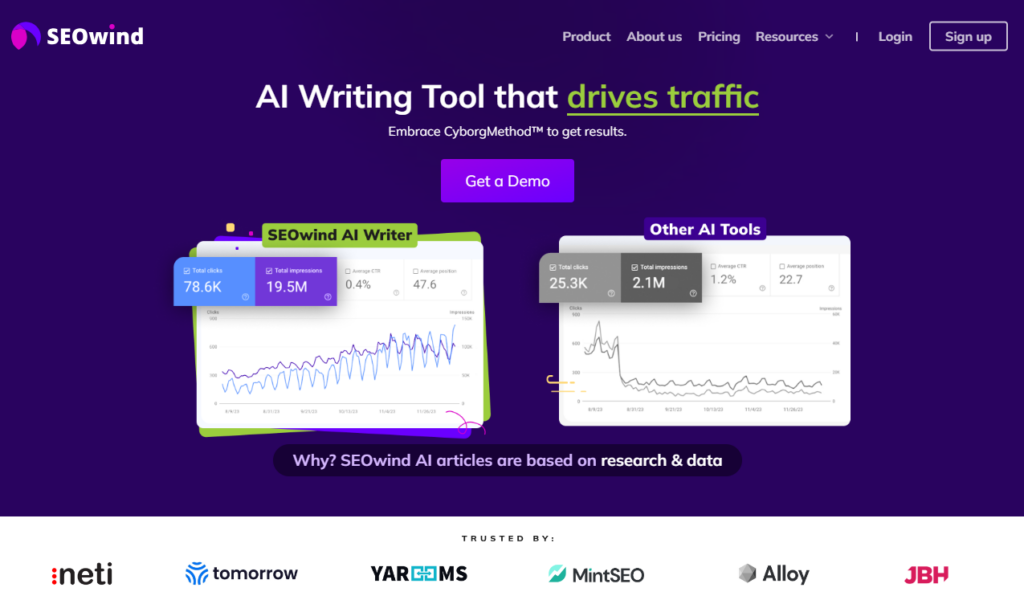
Use AI intelligently – CyborgMethod™
Our digital age enables us to utilize advanced technology like AI in multiple ways. And my go-to advice is to embrace what we at SEOwind term the CyborgMethod™.
The CyborgMethod™ integrates human creative ingenuity with AI’s technological prowess. By implementing this method, you can produce high-grade content that appeals to search algorithms and resonates with human readers.
Here is a brief overview of how you can apply it:
- Start by comprehensively researching your topic and the keywords you intend to target and develop a clear structure.
- Generate articles utilizing an AI tool by providing detailed prompts for effective content creation.
- Make sure to review regularly and refine your AI-generated content for optimal results.

Write AI content, but do the research and add the human touch
One common myth about using AI to create content is that its output lacks depth or substance. In reality, you can achieve this by striking a balance between the strong, data-driven foresight provided by machines, enriched by human intuition and creativity.
So, while SEOwind’s long-form AI writer rapidly creates drafts based on specific prompts, these creations should be viewed more as raw materials than finished products. That means they still require proofreading, editing, and sometimes reorganizing before being considered ready for publication.
AI does not make the research process redundant or replace the human touch. Regarding it as a collaborative effort will enhance your results. Treat your AI tool as an essential team member that generates initial drafts, but let your judgment perfect it afterward.
Publish quality AI content
Quality over quantity. This timeless piece of advice can be applied to your digital content strategy, particularly when you’re focused on regaining lost organic traffic. SEOwind’s promise lies in delivering high-quality, AI-generated content fortified with comprehensive SEO and content research.
Even though you’re automating the writing process using our platform, the end product remains unique because it reflects your personal insights and brand voice. What’s more, SEOwind enriches AI content with stats, data, and internal links. It also lets you feed AI with your unique insights, making AI articles truly unique. Updating your site with consistently top-tier quality posts will gradually replenish diminished organic traffic.
Aim for synergy. Embrace data-driven efficiency with AI, but balance it by adding a generous dash of personal taste and wisdom. Not only will this help restore lost traffic over time, but it’ll also craft an enriching experience for ongoing visitors!
Tactics to combat SERP features impacting organic traffic loss
SERPs have evolved significantly over the years, with algorithms becoming more sophisticated and new features entering the picture regularly. These additions can massively impact your organic traffic visibility if not utilized effectively.
Understanding SERP Features and Their Influence on Website Visibility
To begin, let’s define SERP features. Google introduced them as rich results that offer additional information or data types compared to regular search results. They include local packs, image carousels, knowledge panels, featured snippets, and more.
Each feature has a different appearance and influence on your website’s page ranking and visibility in organic search results.
- Google’s Local Pack: Showcases brick-and-mortar businesses related to your query within a specific geographical context.
- Image Carousel: Visual-rich feature that highlights images relevant to specific keywords or topics.
- Knowledge Panel: Extracts data from various reliable sources, providing concise information about a particular subject or entity.
- Featured Snippets: Provides quick answers directly on the search page without having to click through any link.
Strategically implementing correct schemas can increase your chances of qualifying for these rich results.
Understanding the impact these SERP features can have on your organic traffic is crucial because they change how users interact with search queries and ultimately affect your web traffic potential.
Data from an Ahrefs report reveals that roughly 12% of search queries trigger SERP features that sit above traditional organic listings. Consequently, learning how to leverage these opportunities is indispensable for recovering lost organic traffic.
Tracking SERP Feature Performance and Competitor Analysis
Once you understand SERP features, it’s time to track their performance and analyze competitor influence.
Google Search Console provides essential data regarding individual page performance related to targeted keywords, including average position, click-through rate (CTR), impressions, and clicks. Benchmarking against these metrics will allow you to gauge how well your site is performing relative to SERP features.
For a more detailed analysis, consider using tools like Ahrefs or Moz. These SEO software platforms can help track keyword rankings across multiple SERP features while providing an overview of your competitive landscape.
Keep in mind that tracking SERP feature performance isn’t a one-time activity but an ongoing process. Frequent checks provide insight into algorithm updates and industry-related shifts. Competitor analysis ensures that you can adjust your strategy to realign it optimally with what competitors do successfully.
Understanding SERP features and their impact on your organic traffic, paired with thorough tracking and competitor analysis, is critical when devising tactics for recovering lost margins.
Revising digital marketing strategy to recover organic traffic losses
When trying to recover organic traffic, it’s vital not to overlook the power of an effective digital marketing strategy. As a seasoned webmaster, marketer, or entrepreneur, you may already understand that the online landscape is not static but in constant flux. Therefore, regularly revising your strategy can generate valuable insights into current trends and changes in user behavior.
Audience Segmentation and Personalized Content Creation
Identifying various segments of your target audience can substantially improve the effectiveness of your content creation. Breaking down your audience into smaller groups based on shared traits or interests helps you deliver more personalized content, leading to higher engagement rates.
When segmenting your audience, consider factors like demographics, interests, attitudes, geographic location, and behavioral patterns. Pay special attention to their unique pain points and the questions they are trying to answer. This knowledge will guide you in creating highly relevant content.
One helpful tool for this process is Google Analytics. This platform can provide invaluable data about your website visitors. Utilize these insights when crafting customized content designed specifically for different segments of your audience.
Technical SEO Enhancements for Better Crawling and Indexing
In our quest to recover organic traffic losses, we must also contemplate the technical aspect of SEO. Is your site easily crawlable? Are pages correctly indexed by Google? Ensuring positive responses to these crucial questions primarily relies on successful improvements to your technical SEO.
To begin with, I’d recommend performing a comprehensive audit using tools such as Google’s Search Console or Bing Webmaster Tools, both of which identify potential indexing issues. These problems can stem from faulty redirections or inadequate use of robots.txt files, which instruct crawlers on what areas of the website should be fished out.
Equally crucial is improving page load speed because nothing turns off users—and search engines—more than slow-loading sites. Employ techniques such as compression and minification to reduce the amount of data that needs to be loaded. Also, consider implementing a Content Delivery Network (CDN) to ensure pages load quickly regardless of your users’ location.
Refining your digital marketing strategy and concentrating on technical SEO aspects can be pivotal for recovering from organic traffic declines. It requires vigilance and keen analytical insights. But, most importantly, it demands actions orientated around an all-encompassing understanding of your audience’s interests and search engines’ requirements. Recovery is achievable and should also catalyze long-term growth and resilience for your website’s performance. Stay focused and proactive.
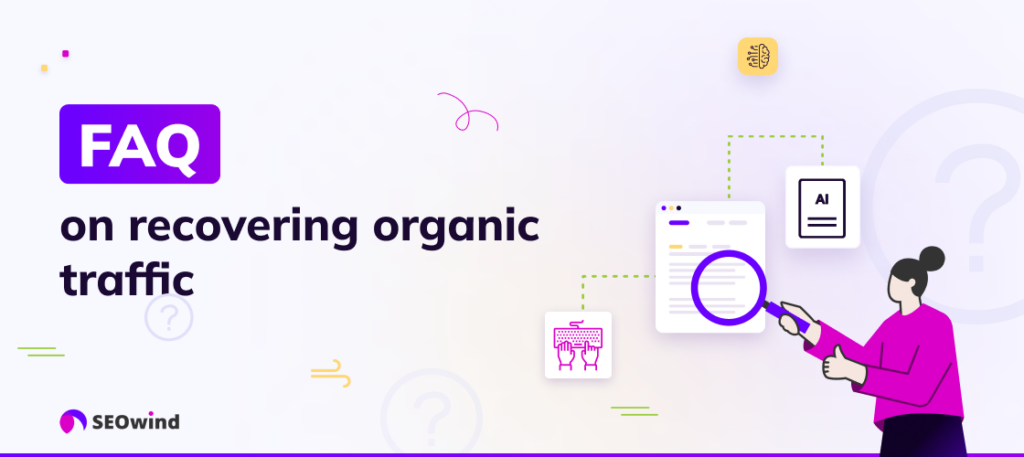
Why is my organic traffic down?
A drop in your website’s organic traffic can happen for several reasons, but it’s not always indicative of your website performing poorly or losing its relevance. Here are a few potential culprits:
- Algorithm updates – Google continually refines its algorithm to produce better search results. Occasionally, even well-optimized sites may experience a dip following an update.
- Technical issues – Broken pages, poor mobile optimization, or slow load times can significantly impact your site’s visibility on search engines.
- Content Quality – If the quality of your content deteriorates or isn’t optimized adequately for SEO, your organic traffic may drop.
- Competitive Market – Sometimes, other players in the market might up their game and outrank you.
- Lost Backlinks – If backlinks pointing to your site get removed or the referencing sites lose credibility, this loss can affect your site’s authority and rankings.
Remember that identifying the cause is half of the solution already!
Helpful Content Recovery Techniques
When facing a slump in your organic traffic due to content-related issues, one effective remedy is improving and enriching your existing material while devising a strategy for creating new, high-quality content.
Primarily focus on relevancy because creating content that resonates with user intent and appeals to their interests is paramount. Keyword research tools like SEMrush or Ahrefs come in handy here by revealing popular queries related to your niche.
Updating older posts with fresh information and more relevant keywords can also enormously help improve your rank, while revamping meta descriptions can lead to a higher CTR.
Comprehensive articles that cover a topic extensively typically perform better on search engines. Think ultimate guides or deep dives into a specific subject matter.
Finally, remember to keep your content original and unique. This isn’t just for the sake of SEO but, more importantly, to offer real value to your readers.
Consider implementing these tactics as you work to recover organic traffic. Regaining your site’s SEO health takes time; work at it constantly and adapt to changes in user behavior and search engine algorithms continuously. Always makes sure to stay informed, proactive, and flexible.


